
Fragile-X Syndrome
Humana Press Inc. (Verlag)
978-1-4939-9079-5 (ISBN)
Cutting-edge and thorough, Fragile-X Syndrome: Methods and Protocols is a valuable tool to help scientists working towards one day developing a therapeutic solution to improve the symptoms of FXS.
Chapter "Induced Neurons for the Study of Neurodegenerative and Neurodevelopmental Disorders" is available open access under a Creative Commons Attribution 4.0 International License via link.springer.com.
Fragile-X Syndrome: Introduction.- Clinical Genetic Testing for Fragile-X Syndrome by Polymerase Chain Reaction Amplification and Southern Blot Analyses.- Monitoring for Epigenetic Modifications at the FMR1 Locus.- Assays for Determining Repeat Number, Methylation Status and AGG Interruptions in the Fragile X-Related Disorders.- One-Step Generation of Seamless Luciferase Gene Knock-In Using CRISPR/Cas9 Genome Editing in Human Pluripotent Stem Cells.- Modeling FXS with Mouse Neural Progenitors.- Using Human Neural Progenitor Cell Models to Conduct Large-Scale Drug Screens for Neurological and Psychiatric Diseases.- Modeling FXS: Human Pluripotent Stem Cells and In Vitro Neural Differentiation.- Induced Neurons for the Study of Neurodegenerative and Neurodevelopmental Disorders.- Imaging of Somatic Ca2+ Transients in Differentiated Human Neurons.- Patch-Clamp Recordings from Human Embryonic Stem Cells-Derived Fragile X Neurons.- Application of Drosophila Model towards Understanding the Molecular Basis of Fragile-X Syndrome.- Comparing Mouse and Human-Based Models for Fragile-X Syndrome Pre-Clinical Research.- Pathophysiology Mechanisms in Fragile-X Primary Ovarian Insufficiency.- Fragile-X Associated Tremor/Ataxia Syndrome (FXTAS).
“The main audience is basic scientists involved in laboratory medicine, but there is enough clinical information to attract the attention of clinicians. Clinical geneticists may find it interesting as the questions asked by current technology provide answers to the phenotypic clinical variances observed. Graduate students involved in fragile X syndrome would find this book essential. … The illustrations are well selected and appropriate.” (Luis F Escobar, Doody's Book Reviews, June 07, 2019)
| Erscheinungsdatum | 08.03.2019 |
|---|---|
| Reihe/Serie | Methods in Molecular Biology ; 1942 |
| Zusatzinfo | 15 Illustrations, color; 10 Illustrations, black and white; X, 192 p. 25 illus., 15 illus. in color. |
| Verlagsort | Totowa, NJ |
| Sprache | englisch |
| Maße | 178 x 254 mm |
| Themenwelt | Medizin / Pharmazie ► Medizinische Fachgebiete ► Neurologie |
| Studium ► 2. Studienabschnitt (Klinik) ► Humangenetik | |
| ISBN-10 | 1-4939-9079-9 / 1493990799 |
| ISBN-13 | 978-1-4939-9079-5 / 9781493990795 |
| Zustand | Neuware |
| Haben Sie eine Frage zum Produkt? |
aus dem Bereich


